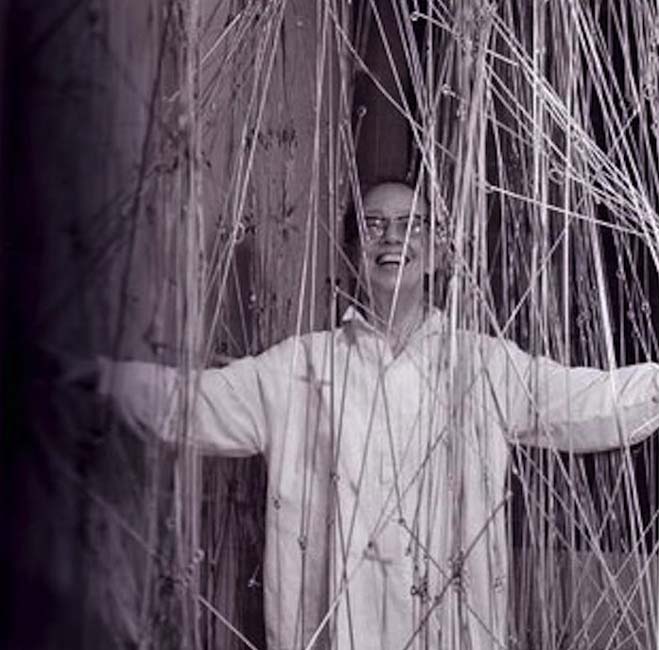IN COLLABORATION WITH FUNDACIÓN GEGO,
DOMINIQUE LÉVY TO PRESENT FIRST LONDON SOLO EXHIBITION FOR A LATIN AMERICAN ICON
Gego: Autobiography of a Line
May 25 – June 30, 2016
Dominique Lévy
22 Old Bond Street London, W1S 4PY
Beginning May 25, 2016, Dominique Lévy is pleased to present Gego: Autobiograpbhy of a Line, the second in the gallery’s pair of exhibitions celebrating the legacy of German-born Venezuelan artist Gego (Gertrude Goldschmidt, 1912 – 1994), and the very first solo exhibition for the artist in London. Organized in collaboration with the Fundacíon Gego, Autobiography of a Line includes a selection of works spanning her entire career. Among these will be three monumental sculptures made in the 1970s, embodying the palpable sense of entropic geometry and spatial play for which Gego’s work is internationally recognised. These works find their parallel in the artist’s towering wire Chorros. Also on view will be a selection of ink drawings on paper and late works that complicate and question the relationship between drawing and sculpture, including Dibujos sin papel (Drawings without paper), Acuarelas (Watercolours), and Tejedruas (Weavings). The exhibition includes loans from the Museu d’Art Contemporani de Barcelona (MACBA), the Museum of Fine Arts Houston (MFAH), and the Fundación Gego.
Autobiography of a Line will remain on view at the gallery’s Old Bond Street space through June 30th.
Originally from Hamburg, Gego immigrated to Venezuela in 1939 after finishing her training as an architect; she was the last member of her Jewish family to flee Nazi Germany. Physically displaced from her homeland, Gego’s fragmentary wire sculptures reflect this state of separation, using the vocabulary of abstraction to mobilise the gaps between lines, languages, and modes of perception. Throughout a career spanning four decades, Gego continuously rejected the categorisation of her work as part of a particular movement or as comprised of a definitive medium, writing in her notebook, “Sculpture: three dimensional forms of solid material. NEVER what I do!” Like other Jewish-German émigré artists — such as Mira Schendel in São Paulo and Eva Hesse in New York — Gego refused to participate in pre-established local artistic discourses. Instead, she dedicated herself to an intensive investigation of both the drawn and the sculptural line, frequently defying conventions of linear geometry to introduce a quiet but profound sense of formlessness into her work.
In the 1950s, at the start of her career, Gego worked mainly in watercolour, drawing, printmaking, and handmade books. Among her books is a slim volume titled Autobiografía de una Línea (Autobiography of a Line), which contains a collection of the artist’s minimal etchings from 1965. The marks in this book, from which the exhibitions at Dominique Lévy and their accompanying catalogue take their name, seem to either converge or branch away from each other depending on the object’s uncertain orientation. In this way, Autobiogrfía de una Línea is a precursor to the concerns that Gego would continue to engage in her later work. The exhibition at Dominique Lévy features two early works on paper, executed around the same period in 1958 and 1964, which similarly depict a central form made of repeating, parallel marks and lines delicately composed in ink.
In 1969, Gego’s career took a radical turn when she created the first Reticulárea (a combination of the Spanish words for ‘net’ and ‘area’) as a site-specific installation for the Museo de Bellas Artes in Caracas. The woven wire sculptures which comprise this work are remarkable for their expanding and collapsing net-like structures that encompass the entirety of their surrounding space. This meditative and ever-changing environment acts as a metaphor for various social and natural universes of interconnecting beings and ideas. Gego subsequently produced a number of works based on the mesh or matrix, to which she gave the same name.
Autobiography of a Line is centred around three large-scale sculptures from the 1970s, each made up of a wire framework and deriving from the Reticuláreas or closely related to them: Columna 71/9 (1971), on loan from MACBA; Columna (Reticulárea cuadrada) (1972), which was acquired from the artist shortly after it was made and has been in the same private collection ever since; and Tronco no. 1 (1974), from a private collection. From this important series the artist developed new bodies of work predicated on the same system, including Dibujos sin papel, which have been interpreted as attempts to wrest the three-dimensionality of the Reticuleareas onto a two-dimensional plane. The exhibition will present five works from this group, including a large work from 1989 of harmoniously overlapping, square gridded structures.
Gego considered the act of line drawing—both on a surface and in space—to be “un trabajo meditativo” (meditative work), and noted that in these works “sometimes the in-between-lines are as important as the line itself.” The concept of “in-between-lines’” can be read doubly as an assessment of the negative space between physical lines and as a meditation on the different technical modes of connection at work in her sculptures and drawings. In this idea the foundation of Gego’s practice—with her fervour for creating connections, breaking them apart, tracing wandering lines, and entwining disparate materials and ideas—comes into focus. By presenting works spanning Gego’s career across two exhibitions in New York and London, Autobiography of a Line seeks to highlight the constancy of these important precepts in her oeuvre and position the artist in an international discourse in which her work remains imminent today.
Courtesy of Dominique Lévy London – Press Release
























